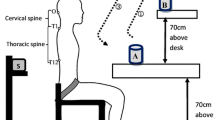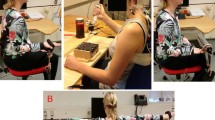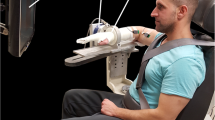Abstract
Complaints of chronic trapezius muscle pain among computer workers have increased in prevalence during the last decade. Currently there is no clear understanding of the pathophysiological mechanisms involved in affected muscles. The major objective of this work was to determine if measurable electrophysiological differences exist between the trapezius muscles in individuals suffering from trapezius myalgia (TM) and occupation-matched pain-free control subjects. Myoelectric signal (MES) data were recorded from the upper trapezius muscle while subjects with and without myalgia performed a standardized series of postural and arm-holding tasks. MES variables reflecting muscle fatigue, muscle tension and motor control strategies were analyzed to determine their potential ability to distinguish between the two groups. One variable, RestTime, was found to be significantly different between the groups but it was not specific enough to predict group association. A multivariate logistic regression analysis yielded a model that separated the two groups with better than 70% sensitivity and 70% specificity. The variables included in the model reflect differences in trapezius muscle activity between the groups, particularly related to motor control and/or active muscle tension, but not fatigue. The model was tested using a small sample of new data, which again produced a good sensitivity (85.7%) but not specificity (42.9%). To the authors’ knowledge, this is the first objective MES-based model that has successfully classified subjects with or without TM based on a simple clinical test. Further work with this model might result in understanding the pathophysiology of TM, assisting with clinical diagnosis, and testing the effect of various treatment interventions.






Similar content being viewed by others
References
Aaras A, Veierod MB, Larsen S, Ortengren R, Ro O (1996) Reproducibility and stability of normalized EMG measurements on musculus trapezius. Ergonomics 39:171–185
Bongers P (2001) The cost of shoulder pain at work. Br Med J 322:64–65
Carayon P, Smith MJ, Haims MC (1999) Work organization, job stress, and work-related musculoskeletal disorders. Hum Factors 41:644–663
Chiu TT, Ku WY, Lee MH, Sum WK, Wan MP, Wong CY, Yuen CK (2002) A study on the prevalence of and risk factors for neck pain among university academic staff in Hong Kong. J Occup Rehabil 12:77–91
Edwards RH (1983) Biochemical basis of fatigue in exercise performance: catastrophe theory of muscular fatigue. In: Knuttgen HG, Vogen JA, Poortmans J (eds) Biochemistry of exercise. Human Kinetics, Champaign, pp 3–28
Ekberg K, Karlsson M, Axelson O, Bjorkvist B, Bjerre-Kiely B (1995) Cross-sectional study of risk factors for symptoms in the neck and shoulder area. Ergonomics 38:971–980
Elert J, Dahlqvist SR, Almay B, Eisemann M (1993) Muscle endurance, muscle tension and personality traits in patients with muscle or joint pain—a pilot study. J Rheumatol 20:1550–1556
Fricton JR (1994) Myofascial pain. Baillieres Clin Rheumatol 8:857–880
Good MG (1950) The role of skeletal muscles in the pathogenesis of diseases. Acta Med Scand 138:284–292
Hagg G (1991) Static work load and occupational myalgia: a new explanation model. In: Anderson P, Hobart D, Danoff J (eds) Electromyographical kinesiology. Elsevier, Amsterdam, pp 141–144
Hagg GM (2000) Human muscle fibre abnormalities related to occupational load. Eur J Appl Physiol 83:159–165
Hagg GM, Astrom A (1997) Load pattern and pressure pain threshold in the upper trapezius muscle and psychosocial factors in medical secretaries with and without shoulder/neck disorders. Int Arch Occup Environ Health 69:423–432
Hagg GM, Suurkula J (1991) Zero crossing rate of electromyograms during occupational work and endurance tests as predictors for work related myalgia in the shoulder/neck region. Eur J Appl Physiol Occup Physiol 62:436–444
Harden RN, Bruehl SP, Gass S, Niemiec C, Barbick B (2000) Signs and symptoms of the myofascial pain syndrome: a national survey of pain management providers. Clin J Pain 16:64–72
Hermans VV, Spaepen A (1995) Perceived discomfort and electromyographic activity of the upper trapezius while working at a VDT-Station. Int J Occup Saf Ergon 1:208–214
Hermens HJ, Hutten MMR (2002) Muscle activation in chronic pain: its treatment using a new approach of myofeedback. Int J Indust Ergon 30:325–336
Jensen C, Westgaard RH (1997) Functional subdivision of the upper trapezius muscle during low-level activation. Eur J Appl Physiol Occup Physiol 76:335–339
Jensen BR, Schibye B, Sogaard K, Simonsen EB, Sjogaard G (1993) Shoulder muscle load and muscle fatigue among industrial sewing-machine operators. Eur J Appl Physiol Occup Physiol 67:467–475
Jørgensen K, Fallentin N, Krogh-Lund C, Jensen B (1988) Electromyography and fatigue during prolonged, low-level static contractions. Eur J Appl Physiol Occup Physiol 57:316–321
Kadefors R, Sandsjo L, Hermens H, Hutten M, Bystrom P, Merletti R (2003) Computer work related shoulder pain: an intervention model XVth Triennial Congress of the International Ergonomics Association and the 7th Joint Conference of Ergonomics Society of Korea/Japan Ergonomics Society, Seoul, Korea
Karasek R, Theorell T (1990) Healthy work. Basic Books, New York
Kilbom A (1999) Possibilities for regulatory actions in the prevention of musculoskeletal disorders. Scand J Work Environ Health 25(Suppl 4):5–12
Kleine BU, Schumann NP, Bradl I, Grieshaber R, Scholle HC (1999) Surface EMG of shoulder and back muscles and posture analysis in secretaries typing at visual display units. Int Arch Occup Environ Health 72:387–394
Leclerc A, Chastang JF, Niedhammer I, Landre MF, Roquelaure Y (2004) Incidence of shoulder pain in repetitive work. Occup Environ Med 61:39–44
Lund JP, Donga R, Widmer CG, Stohler CS (1991) The pain-adaptation model: a discussion of the relationship between chronic musculoskeletal pain and motor activity. Can J Physiol Pharmacol 69:683–694
Lundervold A (1951a) Electromyographic investigations during sedentary work, especially typewriting. Br J Phys Med 14:32–36
Lundervold A (1951b) Occupation myalgia electromyographic investigations. Acta Psychiatr Neurol Scand 26:359–369
Maeda K (1977) Occupational cervicobrachial disorder and its causative factors. J Hum Ergol (Tokyo) 6:193–202
Makela M, Heliovaara M, Sievers K, Inpivaara O, Knekt P, Aromaa A (1997) Prevalence, determinants, and consequences of chronic neck pain in Finland. Am J Epidemiol 134:1356–1367
Mathiassen SE, Aminoff T (1997) Motor control and cardiovascular responses during isoelectric contractions of the upper trapezius muscle: evidence for individual adaptation strategies. Eur J Appl Physiol Occup Physiol 76:434–444
McLean L (2005) The effect of postural correction on muscle activation amplitudes recorded from the cervicobrachial region J. Electromyog Kinesiol 15(6):527–535
McLean L, Goudy N (2004) Neuromuscular response to sustained low-level muscle activation: within- and between-synertist substitution in the triceps surae muscles. Eur J Appl Physiol 91:204–216
McLean L, Tingley M, Scott RN, Rickards J (2001) Computer terminal work and the benefit of microbreaks. Appl Ergon 32:225–237
McLean L, Chislett M, Keith M, Murphy M, Walton P (2003) The effect of head position, electrode site, movement and smoothing window in the determination of a reliable maximum voluntary activation of the upper trapezius muscle. J Electromyogr Kinesiol 13:169–80
Ming Z, Narhi M, Siivola J (2004) Neck and shoulder pain related to computer use. Pathophysiology 11:51–56
Murthy G, Kahan NJ, Hargens AR, Rempel DM (1997) Forearm muscle oxygenation decreases with low levels of voluntary contraction. J Orthop Res 15:507–511
Nederhand MJ, IJ MJ, Hermens HJ, Baten CT, Zilvold G (2000) Cervical muscle dysfunction in the chronic whiplash associated disorder grade II (WAD-II). Spine 25:1938–1943
Nederhand MJ, Hermens HJ, MJ IJ, Turk DC, Zilvold G (2002) Cervical muscle dysfunction in chronic whiplash-associated disorder grade 2: the relevance of the trauma. Spine 27:1056–1061
Nygren A, Berglund A, von Koch M (1995) Neck and shoulder pain, an increasing problem. Strategies for using insurance material to follow trends. Scand J Rehabil Med Suppl 32:107–112
Oberg S, Aström L (2000) Working environment for employed persons, by gender and age, per cent. In: Sweden S (ed) Statistical yearbook of Sweden 2001. Publication Services, Orebro, pp 241–244
Oberg T, Sandsjo L, Kadefors R (1992) Arm movement and EMG mean power frequency in the trapezius muscle: a comparison between surface and intramuscular recording techniques. Electromyogr Clin Neurophysiol 32:87–96
Oberg T, Karsznia A, Sandsjo L, Kadefors R (1995) Work load, fatigue, and pause patterns in clinical dental hygiene. J Dent Hyg 69:223–229
Ranney D (1997) Repetitive strain injuries and cumulative trauma disorders. J Hand Surg [Am] 22:167; author reply 168–169
Sandsjo L (1999) A method for the assessment of muscle rest patterns in ergonomic job analysis. In: Hermans HJ, Merietti R, Rix H, Freriks B (eds) The state of the art on signal processing methods for surface electromyography. Enschede Roessingh Research and Development, pp 137–45
Sandsjo L (2004) Ambulatory monitoring and analysis of surface electromyographic signals in ergonomic field studies: methods and applications department of product and production development division of human factors engineering. Chalmers University of Technology, Goteborg, pp 74
Sandsjo L, Melin B, Rissen D, Dohns I, Lundberg U (2000) Trapezius muscle activity, neck and shoulder pain, and subjective experiences during monotonous work in women. Eur J Appl Physiol 83:235–238
Simons DG, Mense S (1998) Understanding and measurement of muscle tone as related to clinical muscle pain. Pain 75:1–17
Simons DG, Travell JG, Simons LS (1999) Travell & simons myofascial pain and dysfunction: the trigger point manual. Williams & Wilkins, Baltimore
Sjogaard G, Kiens B, Jorgensen K, Saltin B (1986) Intramuscular pressure, EMG and blood flow during low-level prolonged static contraction in man. Acta Physiol Scand 128:475–84
Sjogaard G, Sogaard K, Hermens HJ, Sandsjo L, Laubli T, Thorn S, Vollenbroek-Hutten M, Christensen H, A. K, R K, Merletti R (2004) The NEW-study. Neuromuscular assessment in elderly workers from 4 EU Countries with and without work related musculoskeletal disorders. The 15th Congress of the International Society of Electrophysiology and Kinesiology. ISEK, Boston University
Stokes MJ, Edwards RH, Cooper RG (1989) Effect of low frequency fatigue on human muscle strength and fatigability during subsequent stimulated activity. Eur J Appl Physiol Occup Physiol 59:278–283
Tornqvist EW, Kilbom A, Vingard E, Alfredsson L, Hagberg M, Theorell T, Waldenstrom M, Wiktorin C, Hogstedt C (2001) The influence on seeking care because of neck and shoulder disorders from work-related exposures. Epidemiology 12:537–545
Travell JG, Simons DG (1983) Myofascial pain and dysfunction the trigger point manual. Williams & Wilkins, Baltimore
Vasseljen O, Westgaard RH (1995) A case-control study of trapezius muscle activity in office and manual workers with shoulder and neck pain and symptom-free controls. Int Arch Occup Environ Health 67:11–18
Veiersted KB, Westgaard RH (1993) Development of trapezius myalgia among female workers performing light manual work. Scand J Work Environ Health 19:277–283
Veiersted KB, Westgaard RH, Andersen P (1990) Pattern of muscle activity during stereotyped work and its relation to muscle pain. Int Arch Occup Environ Health 62:31–41
Veiersted KB, Westgaard RH, Andersen P (1993) Electromyographic evaluation of muscular work pattern as a predictor of trapezius myalgia. Scand J Work Environ Health 19:284–290
Waersted M, Bjorklund RA, Westgaard RH (1991) Shoulder muscle tension induced by two VDU-based tasks of different complexity. Ergonomics 34:137–150
Waris P, Kuorinka I, Kurppa K, Luopajarvi T, Virolainen M, Pesonen K, Nummi J, Kukkonen R (1979) Epidemiologic screening of occupational neck and upper limb disorders. Methods and criteria. Scand J Work Environ Health 5(suppl 3):25–38
Westgaard RH, Jensen C, Hansen K (1993) Individual and work-related risk factors associated with symptoms of musculoskeletal complaints. Int Arch Occup Environ Health 64:405–413
Westgaard RH, Jansen T, Jensen C (1996) EMG of neck and shoulder muscles: the relationship between muscle activity and muscle pain in occupational settings. In: Kumar S, Mital A (eds) Electromyography in ergonomics. Taylor & Francis, London, pp 227–258
de Zwart BC, Frings-Dresen MH, Kilbom A (2001) Gender differences in upper extremity musculoskeletal complaints in the working population. Int Arch Occup Environ Health 74:21–30
Acknowledgements
Funding for this research provided by the Nova Scotia Health Research Foundation is gratefully acknowledged.
Author information
Authors and Affiliations
Corresponding author
Rights and permissions
About this article
Cite this article
Goudy, N., McLean, L. Using myoelectric signal parameters to distinguish between computer workers with and without trapezius myalgia. Eur J Appl Physiol 97, 196–209 (2006). https://doi.org/10.1007/s00421-006-0162-4
Accepted:
Published:
Issue Date:
DOI: https://doi.org/10.1007/s00421-006-0162-4




